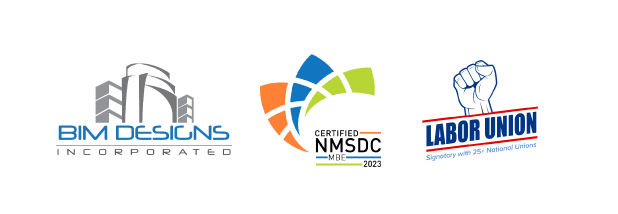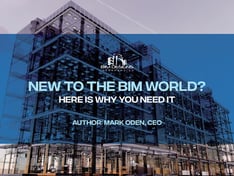
Building Information Modeling has quickly become a global trend. It’s a cost and time-saving process, becoming the standard on many projects to create highly-efficient and collaborative planning, design, and construction.
In the US, nearly half (49%) of builders say they are using BIM in their companies for visualization. The industry itself is growing significantly. It’s projected to grow at a compound annual growth rate (CAGR) of 14.3% through 2027, where experts predict it will reach $15.06 billion in revenue.
More projects are requiring BIM, sometimes through mandates on many government projects. In the UK, a BIM requirement was put in place after an analysis showed that BIM saves up to 20% on construction costs. In other terms, by utilizing BIM LOD (Level of Development) 300-400, £900 million was saved (roughly $1 billion USD) over the six years studied.
What is Building Information Modeling (BIM)?
Building Information Modeling (BIM) is a collaborative process, allowing multiple stakeholders and architecture, engineering, and construction (AEC) professionals to work together on the planning, design, and construction of projects through a 3-D model. It provides a real-time update at each stage of the process.
Using advanced building and design solutions, BIM helps create virtual representations that afford risk mitigation by anticipating clashes for earlier identification. BIM reduces surprises in the building process and can reduce overall costs in construction projects.
A coordinated database lets owners, project managers, estimators, and other stakeholders to make data-driven decisions before and after the building is completed. It can help with estimating, budgeting, and operations/management for the building’s lifecycle.
Building Information Modeling Objects
BIM objects are the components that contribute to the model. When elements are changed, the software will update the model to reflect the change throughout. This keeps everything coordinated through the process and shows how it will impact cost, timelines, and other resulting changes.
This helps all the stakeholders in the construction chain – Project Managers, MEP Construction Managers, Lead Estimators, Designers, Architects, Structural Engineers, and Contractors – to work together using a common database of information.
Common Data Environment (CDE)
Information sharing is the key to a successful Building Information Modeling application. A Common Data Environment, or CDE, is the central storage spot for data collected as part of the information modeling. It is accessible to stakeholders and can hold information for every stage of the building’s construction process into operations. Facilities teams can leverage the BIM model to support the building after construction, and it can also be used for future renovations.
Building Information Modeling Solutions
When builders were asked to evaluate how Building Information Modeling solutions helped them with projects, here is how they ranked the benefits that BIM brings:
The Top Ten Benefits of BIM
- Coordination/Clash Detection
- Visualization
- Project Planning
- Estimating
- Virtual Mock-Ups
- Prefabrication
- Selling and Presentations
- Take-offs
- Scheduling
- Value Analysis
Builders also listed code compliance, facility management, and other reasons for their success using BIM methods.
Building Information Modeling for Project Managers/MEP Construction Managers
If you’re a Project Manager or MEP Construction Manager, you’re likely obsessed over project timelines and budgets. In every building project, you’re managing the team to optimize spending, manage the project flow, bring projects in under budget and on-time, and deliver a quality building.
BIM helps by providing a virtual blueprint for projects to help better manage the budgeting of expenses and resources.
One thing PMs need to think about is how BIM can impact future costs for building operators. Once a building is complete, the majority of costs of the asset is tied up in operations and facilities management. BIM can help estimate these costs. It can show the impact on future expenses when more efficient assets – that are cheaper to maintain and operate – are used in a project.
Building Information Modeling for VP of Estimating or Lead Estimators
For Estimators, charged with creating bids that are the most cost-efficient with the most deliverables, bids need to be turned around quickly.
Building Information Modeling software and estimator tools can help bring transparency to the estimating processes, delivering insight into what drives budgeting and scheduling. BIM helps identify staffing and resource needs, and helps build the phasing of contractors, vendors, and resources. It provides concrete data that can be used to generate accurate forecasts.
Building Information Modeling Levels
There are different levels of Building Information Modeling, known in the industry as levels of development (LOD), that refer to project level maturity. Each requires meeting different sets of criteria to reflect the accuracy of the design elements and potential uses. BIM Level 200 compliance is typically considered the minimum standard to be considered BIM-compliant.

LOD 100
LOD 100 is a conceptual level of the project where basic structural details such as area, volume, orientation, and cost are estimated. At its most primitive model, LOD 100 might be skipped altogether when a project begins.
LOD 200
LOD 200 is a more developed design level than LOD 100, where the model’s geometric attributes as well as any systems within the building are approximated. According to the U.S. General Services Administration:
“This is one of the longest phases that any model will go through, as it encompasses both the traditional schematic design as well as design development efforts.”
LOD 300
LOD 300 more precisely and accurately models the project. Structural and systematic elements are clearly defined and confirmed with the use of 3D modeling. At this point in the project timeline, major clashes should be determined and resolved.
LOD 400
LOD 400 allows for full fabrication and assembly of the project off of the created model. It is often defined as the installation phase. At this level, all parties should be collaborating, to ensure the precise aspects of the entire project before moving forward with prefabrication and construction.
LOD 500
LOD 500, or the as-built level, provides an exact model of the building as it was built. With this real-life representation, facilities teams can utilize the model's intelligent elements to maintain the building’s overall health, easily plan and execute any future remodels, and even in preparation for the potential sale of the building and handoff to future owners.
Conclusion
BIM allows project teams to plan within in the digital world before building in the physical world. It leads to reduced risk, less waste, and fewer change orders and other bumps in the construction process that lead to cost overruns and scheduling delays.
About BIM Designs, Inc.
BIM Designs, Inc. is an agile BIM design, modeling, consulting, and coordination service provider for architecture, engineering, and construction (AEC) contractors and developers that desire experienced journeymen detailers and engineers for Mechanical, Electrical, Plumbing and Fire Protection (MEPF) modeling, Laser Scanning, and Virtual Design Construction (VDC) projects.
If you need 3D BIM modeling, design, and MEP detailing services, BIM Designs, Inc. (BDI) has the expert tradesmen who know how to precisely design and model your systems. Contact us today for a free estimate or to discuss your project needs.

About the Author
Steve Couch is the Head of Sales and Marketing for BIM Designs, Inc, and is based in Phoenix, AZ. He manages the marketing, sales, and estimating teams to drive revenue and expand client portfolios. An avid international traveler and award-winning public speaker, his experience in public relations, organizational leadership, project management, and communications make him a natural relationship builder, and enables him to build strong community and corporate partnerships.





